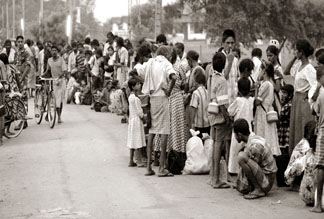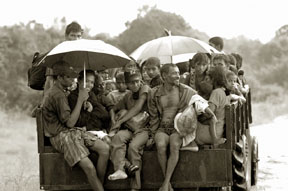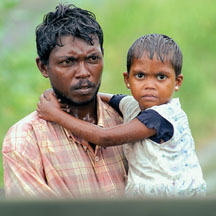|
observer |
|
|
|
|
|
OTHER LINKS |

|

|

|
Tale of the Vakarai exodusReedeethanna: The de- facto receiving point of vakarai refugees
Reedeethanna is a remote security outpost, few kms into the jungle on Polonnaruwa-Batticaloa road. It now functions as a receiving point for a daily exodus of 2,000 - 3,000 civilians fleeing fighting in besieged Vakarai, the last bastion of the LTTE in the East.
Hundreds of men and women, most of them barefoot, walk in en masse. What unfolding here was the largest exodus of civilians in ten years. A fresh flare up of fighting in Vakarai two weeks ago, which saw heavy artillery and mortar dual between the security forces and the LTTE triggered a exodus of civilians to the government controlled areas of Valaichchenai and Selvanagar. As fighting scaled down last week, thousand of civilians trekked the jungle footpaths to arrive in Valaichchenai. According to statistics by the Army, over 22,586 civilians have arrived in government controlled areas. During the height of the exodus, that sent thousands of civilians fleeing fighting, desperately carrying a few pots and clothes, their only wealth. There are still, 15,000 civilians in Vakarai, some being unable to flee and others, most of them, the so-called Maveerar families, reluctant to leave LTTE held area. Sensible optionFor civilians who trekked through the jungle footpath, crossing marshy lands, a lagoon and a hostile jungle, this was the only sensible option available for their survival. But, their experiences are an endless of tale of misery. Under heavy rain, teenager, Krishnapillai Shiva (17) waits for the rest of her extended family. She along with her father, mother and few other relatives have made it to Reedithanna, from where the family could receive transport in an army tractor to Punani, four km from Reedeethanna.
Shiva was preparing for the Advanced Level exam when the fresh fighting flared up, forcing her entire family to flee Vakarai. Like many other displaced, she could not say what the future will hold for her and her family. The only consolation was that they made it alive, travelling in extremely harsh terrain evading the eyes of the LTTE cadres, who could have turned them away, if they caught Shiva and her family along with intermittent shelling by the two warring parties. The journey from Vakarai to Valaichchenai is an episode of an untold misery. According to civilians, LTTE cadres guard key exit points to avoid people leaving the Tiger held area. Shiva's familyShiva's family set off from Vakarai on Saturday night and made it to Reedeethanna on Monday morning. Shiva's father said the LTTE terrorists keep vigil till 2 a.m. in the morning. People flee Vakarai in the wee hours when the LTTE lose concentration. So did Shiva's extended family and indeed, they were lucky- if the term fits to a people who suffered immensely most of their lives - to complete their journey within one and half a day. Many civilians travel for days, some 3-4 days along jungle pathways and some were turned back by the LTTE. On their way lies the Upparu lagoon. Families are scattered as they trek their way. A young man, carrying his infant child, waits for his wife to emerge from the crowd. Humanity runs beyond the frontier of the skin. A few tractors owned or rented by locals provide a form of rudimental shuttle service for the displaced people free of charge. The breast feeding wife of this young man has been offered a place in such a tractor.
As heavy rain lashed the ground, the umbrella was a poor guard. The infant, sleeping on the shoulder of the young man was not spared, despite the feeble effort by the young man to shield his kid from torrential rain. Upparu LagoonMany a tragedy was unfolding on those jungle footpaths. The Upparu Lagoon is filled with water in this rainy season. People have to walk one kilometre stretch crossing the lagoon, of which 200 meters was neck deep. One shocking story is about a pregnant young woman who gave birth to a child while crossing the lagoon neck deep in the water. The child died. The woman threw away the lifeless body of the infant and still suffering from pain and trauma trekked the rest of the journey to Reedeethanna. She was admitted to Polonnaruwa hospital, a senior security forces official said. Several soldiers also confirmed the incident which however could not be verified with the Polonnaruwa Hospital. But, another woman, Latha was lucky, at least to receive basic medical care when she delivered her child, also on her way to Reedeethanna. Soldiers on duty could call the service of two male nurses who were on some other assignment. She delivered the child in a makeshift labour room, made out from a security post. Soldiers took her and the new born baby to the Polonnaruwa Hospital. Vakarai is only six km from Kajuwatta, the last security forces outpost, but people have been forced to flee along jungle footpaths as the Tiger cadres prevent them leaving the area. Pavaranda Rasa (28) was caught by the LTTE when he and his cousin brother were about to cross the lagoon. The LTTE cadres took his cousin by force and when people tried to prevent them, fired in to the air. The LTTE let the rest of the team to go, but took Kandasamy Dayabaran (18) with them. "They beat him with sticks and tied his hands behind before taking him away," said Pavaranda Rasa, still grieving the loss of his cousin. The reason for the abduction: Dayabaran is an LTTE deserter. "They(LTTE) came to our house and took him four months ago. He ran away and came home last week and we decided to come to Valaichchenai." Dayabaran's fate is still not known. But, an intelligence officer said the security forces knew over 100 ex-Tiger cadres are among the IDPs who arrived in government controlled area. Some intelligence operatives say they could pick an LTTE cadre from a crowd of civilians. "We know there are LTTEers among the crowd, but as long as they desist violence, we have no reason to arrest them. Main thing right now is to encourage people to leave Vakarai,' he said. A senior military official, sounded confident enough of existing counter terrorist mechanism in the East. "Even if these guys (LTTEers) plan violence here, their chances are slim. Maximum, they could blow up a claymore or lob a grenade," he said. "However, we keep an eye on them. After all, if they want to leave the LTTE, that is a good thing." Twelve-year-old- Chandramohan has his childhood devastated. The boy could speak fluent Sinhala thanks to his early- and, sadly, only- education in Colombo. His mother died a year ago of fever and father shot dead by the LTTE which charged him of a murder.(Chandramohan, however, insists that his father went to help, having seen a fellow villager shot by an unknown gunman) "LTTE cadres saw my father holding the bleeding man. They charged him killing the man and shot and killed him instantly," said Chandramohan. Whatever the justifications of the killing, it ruined a family. To add further agony, his uncle and another relative of his extended family were killed in shelling. Chandramohan and his 14-year-old brother trekked a jungle foot path for three days to reach Punani IDP camp. His cousin sister, a twenty-year-old girl, her body is evident of harsh life she is forced to live- stares at us, a blank look on her face. She is desperate, having been forced to flee with her three children, youngest being only one year. Above us, dark clouds are about to crack. Thousands of civilians trekking the jungle path would have no choice but to brave the hostile weather. The LTTE denies keeping civilians as human shield. But, according to evidence of civilians who made their way to government controlled areas, they were not allowed to leave. Chandramohan said one of his brothers was still stranded in Vakarai. He and his brother fled the IDP camp they were sheltered in Kaddamurichchikulam, posing as visiting home to pick some essentials. But, his elder brother could not join and Chandramohan fears the life of his brother. Due to the presence of LTTE cadres, civilians evade travelling on the A 15 road from Vakarai to Mankerny. However, security forces complained that the LTTE had booby trapped the Panichchankerny Bridge which links Mankerny with Vakarai. The security forces refers to a confession by a senior LTTE cadre named Selvadorai Mahendran, who surrendered to the Army on 14 Nov 2006. He said he played a key part in booby trapping the bridge with four unexploded 1,000 kg bombs in the mid October this year. He further said those bombs were connected to each other and could be exploded simultaneously using a single detonator located in a LTTE bunker on the bank of Vakarai. The LTTE exploded a part of the Panichchankerny bridge on October 6 when the security forces conducted a ground operation following an attack on military outposts in Kajuwatta and Mankerny. The security forces have said that given their experience in handing unexploded bombs, there was a greater danger that they could explode with even the slight shock also known as sympathetic detonation. They fear civilians could unknowingly cause the detonation. The security forces earlier demanded the proper inspection of bridge before any movement over the bridge is carried out. There are reports emanating from civilians who arrived at Valaichchenai that the LTTE on certain occasions fired at fleeing civilians. One occasion, when LTTE fired at a group of people on their way to Reedeethanna, the women in the team force their way before the LTTE cadres and grabbed them to prevent them from firing. "Women told them: shoot us, not our boys," said one civilian who requested anonymity for fear of reprisals. The security forces state, referring to the confession by Selvadorai Mahendran that the mine laying group led by him had buried 8,000 anti-personnel mines. Army says it is confirmed of the content of Mahendran's confession as several soldiers have already become mine casualties. According to information from civilians, the LTTE has located its artillery and mortar batteries in the vicinity of the IDP camps. This is to deter the counter battery fire by the security forces. This also expose civilians to an extreme danger. The LTTE has refused a government offer to set up safe havens for civilians in Vakarai. However, the recent exodus of civilians from Vakarai signals that the LTTE was losing its grip in the area. Till the end of November, only a trickle of movement of civilians to government controlled area was seen. Losing groundFollowing the flare up of intense fighting three weeks ago, which has now subsided, civilians began fleeing Vakarai en masse. That is a sign that the LTTE is losing ground. The security forces have closed on Vakarai, the besieged Tiger controlled coast town. But, the presence of civilians have forced a restrain on the use of heavy guns. Hence the troops rely on small team operations of Special Force commandos. There are reports that the LTTE is planning to move its artillery guns from Vakarai. According to information, there are six artillery guns in Vakarai, including one 152 mm heavy artillery gun. Civilians claim they were fleeing Vakarai without the knowledge of the LTTE. But, given the massive exodus, such a claim is open to question. It is hard to believe that LTTE could not notice when two thousand civilians flee their houses trekking the jungle pathways. Another opinion is that the LTTE has lost control over the people. Its administrative apparatus have collapsed. But, for civilians who braved heavy rain, poisonous snakes and a lagoon to reach government controlled area future remains uncertain. At a refugee camp in Selvanagar, an elder woman sits on the ground waiting for her first cooked meal in four days. She had led her whole extended family out of Kathiravelu. Many of them walked barefoot, grabbing whatever few things they have been left with. An old man brought his chicken with him, stuffed them in a gunny bag. But some people came empty handed. They simply have nothing left. These men and women survived a long journey, which exposed them to many a danger. But, some of them have not given up their spirit. Despite trauma at displacement and many a personal tragedies, some try hard to be cheerful. An old man in his early 60s, in a queue waiting to undergo a security check, glances at me and smiles. He had travelled for four days from Palchenai, eating only one meal a day. He could not say what the future will hold for him or children like Chandramohan, who would be the age of his grandson. This war has devastated three generations. Two days after on my return to Colombo, I had a heavy nose. Exposure to torrential rain has its effect. I could only pray for the health of those old men and hapless women - and of course, for that of the sleeping child the unknown young man so desperately tried to shield from heavy rain. |
 Torrential rain lashed Reedeethanna forcing us to seek cover in a
busty tree canopy. Those hapless civilians, many a woman and child were
fleeing fighting in Vakarai in this nasty weather. Weather is not kind
to them. But, they have already lost a great deal to a man made
calamity.
Torrential rain lashed Reedeethanna forcing us to seek cover in a
busty tree canopy. Those hapless civilians, many a woman and child were
fleeing fighting in Vakarai in this nasty weather. Weather is not kind
to them. But, they have already lost a great deal to a man made
calamity. 










